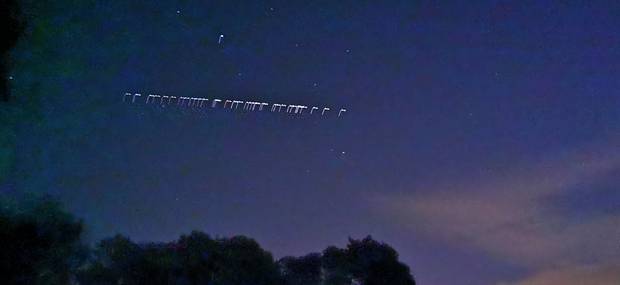
People reported seeing an "extremely odd" string of 30-40 lights crossing the night sky in a straight line from east to west, with some speculating they were UFOs on social media on Saturday night.
While it initially alarmed many residents, the string turned out to be a launch of 60 satellites by Elon Musk's company SpaceX.
Grant Christie, of the Stardome Observatory, says sunlight was being reflected from the satellites, launched to deliver broadband internet around the globe.
But Christie says the number and brightness of satellites launched by companies such as SpaceX and OneWeb is becoming a problem for some astronomers.
People reported seeing them in spots from Foxton in Manawatu to the Waitakere Ranges in Auckland, and even as far away as Tasmania, according to reports made to Weatherwatch's meteor sighting page.
"This travelled right over top of the house moving from the west heading toward the Tararuas quite quickly," said a person in Foxton. "I've never seen a Chinese lantern like that - I"ve seen them float upwards but not as quick as this or in a long line," the person said.
"Saw dozens of lights traveling while out hunting tonight at 10.08pm. Was pretty freaked out and [to be honest] I thought I had seen a UFO," said another.
If you missed all the excitement, there will be plenty more opportunities to see the light show. SpaceX has so far launched 240 satellites but has plans for an initial constellation of 12,000, and reportedly eventually wants 42,000 orbiting the earth.
SpaceX's plans have raised serious concerns from astronomers and dark sky campaigners who say the satellites will ruin the night sky forever.
Just over 9000 stars are visible in the entire night sky - meaning they would be far outnumbered by SpaceX's satellites.
The satellites reflect sunlight, making them brighter than most stars, while their rapid movement through the sky creates trails that interfere with astronomers' work.
Otago Museum director Ian Griffin - a renowned aurora spotter and dark-sky enthusiast - has made his feelings known on Twitter, tweeting that there was a "night sky emergency".
In 2018, Griffin was also scathing of the decision by New Zealand's Rocket Lab to launch a giant glittering "disco ball" into space, saying the company had "vandalised the night".
Leading satellite mega-constellation companies SpaceX and OneWeb have met with astronomers in Europe to discuss the impact their operations could have on observations of the Universe.
The parties discussed the issues in a private meeting at the Royal Astronomical Society in London. The talks were described "as positive".
Present for OneWeb was Dr Timothy Maclay, the start-up's director of mission systems engineering; and for SpaceX, the participant was Patricia Cooper, the California company's vice president of satellite government affairs.
OneWeb and SpaceX are in the process of launching big networks of spacecraft to deliver broadband internet to every corner of the globe.
The numbers of platforms involved are unprecedented in the history of spaceflight.
The RAS gathering was intended as an opening move in what is hoped will become a continuing dialogue. Media were excluded to allow the delegates to have a frank discussion, RAS deputy executive director and press officer, Robert Massey, told BBC News.
It's understood two new, soon-to-be published research studies were presented.
One, from the University of Southampton, has investigated the reflectivity of SpaceX's Starlink satellites and what's driving their brightness in the sky.
The second, from the European Southern Observatory organisation, has attempted to model how much observing time might be lost by the world's major telescope facilities if the mega-constellations' interference is as bad as some fear it could become.
Already, astronomers have talked of passing Starlink satellites producing streaks and "ghosting" in telescope images; and of detectors becoming saturated in the glare from the satellites.
As well as SpaceX, OneWeb is planning a big rollout from next week. The company only has six spacecraft up at the moment but will see 34 satellites being lofted every month or so until 650 platforms are circling the globe.
SpaceX is already in discussions with the American Astronomical Society. It's the wide-field survey telescopes that could suffer most. These will scan large portions of the sky every night looking for opportunity targets such as passing asteroids and exploded stars, but these searches could become compromised if astronomers also have to account for large numbers of confounding artificial light sources.
Dr Massey told BBC News: "We appreciated the openness of the two companies; we appreciated the fact that they came to see us and to talk to us. We know that they're not the only operators out there and we need to be having discussions with those people as well. But I think we started to understand some of the genuine quantitative impacts on optical and radio telescopes."
The absence of an internationally agreed framework to guide the satellite industry on the brightness of its satellites, giving it some standards to work to, was one of the issues raised at the meeting, Dr Massey added.
He contrasted this with the best-practice measures designed to mitigate space debris.
Operators are urged to pull defunct spacecraft out of orbit within 25 years to reduce the chances of a collision with active platforms.
SpaceX has modified one of its satellites to have a different coating which may help reduce its reflectivity. However, the suspicion is that much of the brightness comes from light bouncing off the long singular solar array incorporated into the Starlink design.
The RAS meeting also included representatives from the UK and European space agencies, and from the Square Kilometre Array.













